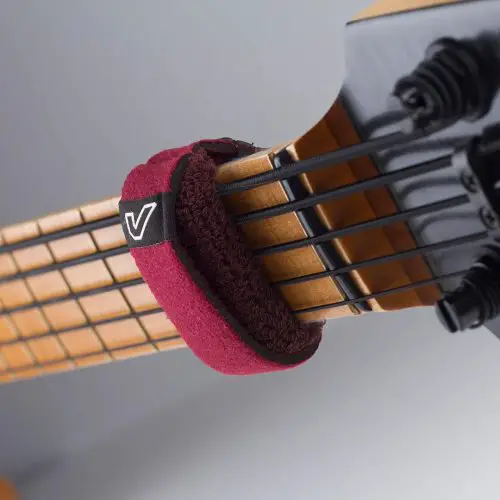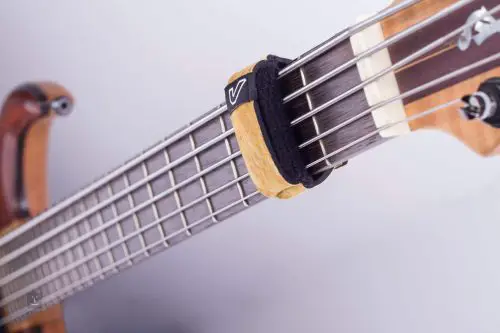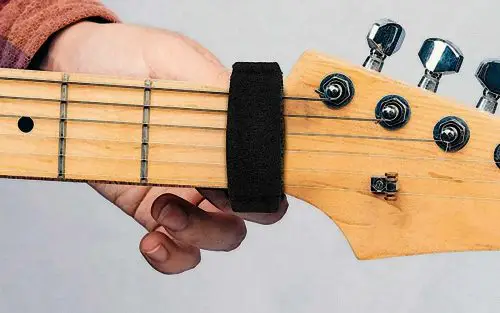Using a fret wrap is not considered cheating in the music world. It is a tool that many guitarists, bassists, and other string instrument players use to improve their playing.
A fret wrap, also known as a string dampener, is a device that is placed on the neck of the instrument to dampen unwanted string vibrations. It can be used to mute or control the ringing and overtones that can occur when playing certain techniques or chords.
While some may argue that using a fret wrap is a form of cheating because it helps to eliminate unwanted noise, it is important to remember that playing an instrument is about expressing oneself and creating music. If using a fret wrap helps a musician achieve the desired sound and control over their instrument, then it is a valid tool to use. It is simply a matter of personal preference and style.
As a guitarist myself, I have used a fret wrap in certain situations where I wanted to achieve a cleaner and more precise sound. For example, when playing fast legato lines or intricate tapping patterns, using a fret wrap helped to eliminate any unwanted noise and allowed me to focus on the clarity and fluidity of the notes.
Additionally, when experimenting with unconventional techniques such as two-hand tapping or slap bass, a fret wrap can be extremely useful in controlling the resonance and sustain of the strings. It helps to create a more controlled and percussive sound, which is often desired in these styles of playing.
However, it is important to note that a fret wrap should not be solely relied upon to cover up technical deficiencies or lack of practice. It is not a shortcut to becoming a better musician. Developing proper technique and practicing regularly are still essential components in becoming a skilled and proficient player.
Here’s a summary that sums up the entire article if you are too busy. Otherwise, read till the end because there are much more to the topic!
| Subheader | Summary |
|---|---|
| Is it cheating to use a fret wrap? | Using a fret wrap is not considered cheating in the music world. It is a tool that can improve playing by controlling unwanted string noise. |
| Why do guitarists use fret wraps? | Guitarists use fret wraps to control string vibrations, achieve a consistent sound, and facilitate specific playing techniques. |
| Can you play open notes with a fret wrap? | Yes, it is still possible to play open notes with a fret wrap. The tightness and positioning of the wrap can determine the level of muting. |
| How tight should a fret wrap be? | A fret wrap should be tight enough to effectively mute strings but still allow for comfortable playing and easy fingering. |
| Should you use a fret wrap? | The decision to use a fret wrap depends on personal preference, playing style, and the need to control string noise. |
| Is using a fret wrap helpful for acoustic guitarists? | Yes, using a fret wrap can help acoustic guitarists control sympathetic vibrations and mute open strings when needed. |
| Are there any disadvantages to using a fret wrap? | Some potential disadvantages include needing to adjust playing technique, limitations on certain techniques, aesthetic impact, and cost. |
| What are some alternatives to using a fret wrap? | Alternatives include palm muting technique, adjusting finger pressure, using a lighter touch, and instrument setup adjustments. |
Why do guitarists use Fret Wraps?

Fret wrap minimizes unwanted vibrations and ringing
Guitarists use fret wraps for a variety of reasons. One of the main reasons is to control unwanted string vibrations and ringing. When playing certain techniques, such as tapping or legato, strings that are not being played can resonate and create unwanted noise.
A fret wrap helps to mute these strings, resulting in a cleaner and more focused sound. It allows the guitarist to have better control over the notes they are playing and eliminates the distractions caused by extraneous string noise.
Here’s a list of reasons why musicians use fret wraps:
- Control and minimize unwanted string vibrations and ringing that can occur during specific playing techniques, such as tapping or legato. By muting the unused strings, fret wraps create a cleaner and more focused sound, allowing the guitarist to have better control over the notes they play and reducing distractions caused by extraneous noise.
- Fret wraps help achieve a more balanced and consistent sound across all strings. Some strings might naturally ring out louder than others due to differences in tension or resonance. Applying a fret wrap allows the guitarist to dampen the strings, ensuring a more uniform sound, which is particularly advantageous when playing chords or arpeggios, as it guarantees that all notes are heard clearly and at the same level of intensity.
- Fret wraps are useful in facilitating certain playing techniques. When executing complex two-hand tapping patterns or rapid legato lines, a fret wrap can dampen the open strings, preventing them from unintentionally sounding and resulting in a smoother and more accurate performance without unwanted noise.
- Some guitarists simply prefer using fret wraps because they appreciate the feel and response it provides to their instrument. It offers a sense of security and control, allowing them to focus on their playing without being distracted by unwanted noise or uneven string response. This aspect becomes particularly crucial during live performances, as fret wraps ensure a consistent and clean sound across various playing situations.
Can you play open notes with a fret wrap?
You can still play open notes with a fret wrap. A fret wrap is designed to dampen or mute the vibrations of the strings, but it does not completely silence them. It allows for the strings to still produce sound when played open, albeit with some reduction in volume.
While the fret wrap helps to control unwanted string noise and ringing, it does not interfere with the ability to play open notes on the instrument.
Elaborating on the topic, it’s important to note that the effectiveness of a fret wrap in muting open strings may vary depending on the design and placement of the device. Some fret wraps are adjustable or have multiple layers, allowing for different levels of dampening. This means that players can customize the amount of muting they desire and find a balance that suits their playing style and preferences.
When playing open notes with a fret wrap, it’s crucial to position the device correctly. Placing the fret wrap too close to the fret where you want to play the open note can result in partial muting of the string, reducing its volume or causing a choked sound. Therefore, it is necessary to experiment with the placement of the fret wrap to achieve the desired balance between muting unwanted noise and maintaining the desired clarity of open notes.
Additionally, the type of music being played can also influence the decision to use a fret wrap while playing open notes. For certain genres or styles, such as classical or fingerstyle guitar, where the open strings are often utilized for drone notes or to create a specific tonal character, using a fret wrap may not be as necessary or desirable. On the other hand, in genres where a cleaner and more controlled sound is desired, such as jazz or metal, a fret wrap can still be beneficial for muting any unwanted string noise while playing open notes.
How tight should a fret wrap be?

Fret wrap shouldn’t be too tight that it negatively impacts your play, but shouldn’t be too loose either.
Generally, a fret wrap should be tight enough to effectively mute or dampen the strings, but not so tight that it negatively affects the playability of the instrument. It should provide enough pressure to control unwanted string vibrations, but still allow for easy fretting and bending of the strings.
It is important to find the right balance when adjusting the tightness of a fret wrap. If it is too loose, it may not effectively dampen the strings and allow for unwanted noise and overtones to persist. On the other hand, if it is too tight, it can interfere with the ability to fret notes properly or cause excessive string buzz.
To determine the optimal tightness, it is recommended to start with a slightly loose fit and gradually tighten the fret wrap until the desired amount of string dampening is achieved. It may require some trial and error to find the perfect tension that works best for each individual’s playing style, instrument, and preferences.
Different fret wraps on the market offer adjustable features, such as Velcro straps or elastic bands, to help achieve the desired tightness. These adjustable options allow players to find the ideal balance between string dampening and ease of playing.
It is also worth noting that the tightness of a fret wrap may vary depending on the specific playing technique or musical context. For instance, when playing fast or intricate passages, a tighter fret wrap may be preferred to ensure clean and controlled notes. In contrast, when playing slower, more expressive passages that require a wider vibrato or bending, a slightly looser fret wrap may be more suitable to allow for greater string movement.
Should you use a fret wrap?

Experiment with fret wrap to know if it’s for you.
Whether or not to use a fret wrap ultimately depends on individual circumstances, playing style, and personal preference. There are a few factors to consider when deciding if a fret wrap is right for you.
- Assess your needs and playing style. If you frequently encounter issues with unwanted string noise, such as when playing fast legato lines, tapping, or using unconventional techniques, a fret wrap can be a valuable tool to help control and minimize these undesirable sounds. It can provide a cleaner and more controlled sound, allowing you to focus on your playing and expression.
- Consider the genre or style of music you primarily play. Different musical genres have different sonic characteristics and requirements. If you play genres where a clean and precise sound is essential, such as jazz or metal, a fret wrap can be particularly beneficial in achieving the desired clarity and articulation. Also, if you primarily play genres that rely heavily on open strings for their unique tonal qualities, such as folk or acoustic fingerstyle, a fret wrap may not be as necessary or desirable.
- Factor in your instrument and setup. Some guitars or basses have inherent characteristics that may contribute to more string noise. If you find that your instrument tends to ring or resonate excessively, especially on certain strings, a fret wrap can help mitigate these issues and provide a more balanced sound.
- Consider personal preference. Everyone has different playing styles and preferences. Some players may feel more comfortable and in control of their instrument with a fret wrap, while others may find it limiting or unnecessary. Experimenting with a fret wrap during practice sessions or performances can help you determine if it aligns with your playing style and enhances your overall playing experience.
Is using a fret wrap helpful for acoustic guitarists?
Using a fret wrap can be helpful for acoustic guitarists as well. While the need for damping unwanted string noise might not be as prominent in acoustic guitar playing compared to electric guitar playing, there are still situations where a fret wrap can be beneficial.
Elaborating on the topic, acoustic guitars can produce sympathetic vibrations when certain strings are played, causing unwanted resonance and sustain. This can be especially noticeable when playing complex chord voicings or using fingerpicking techniques.
A fret wrap can help to control these sympathetic vibrations and reduce the overtones, resulting in a cleaner and more focused sound. It allows acoustic guitarists to have better control and articulation while playing intricate passages or chords.
In addition to controlling sympathetic vibrations, a fret wrap can also be useful for muting open strings on an acoustic guitar. When fingerpicking or using percussive techniques like slaps or taps on an acoustic guitar, some strings may produce unintentional noise or rumble. By applying a fret wrap, these open strings can be effectively muted, allowing for a more percussive and controlled sound.
It’s important to note that the choice of a fret wrap for acoustic guitar should be made based on the specific needs and preferences of the guitarist. Some fret wraps are designed specifically for acoustic guitars, taking into consideration the wider neck and the ability to fit comfortably without interfering with the sound or playability. It’s recommended to choose a fret wrap that is compatible with an acoustic guitar and allows for easy positioning and adjustment.
Can a fret wrap improve a beginner guitarist’s playing?
A fret wrap can certainly improve a beginner guitarist’s playing. When first starting out, beginner guitarists often struggle with controlling unwanted string noise and achieving clean, clear notes. A fret wrap can help address these challenges and provide a more enjoyable playing experience.
One of the main challenges for beginner guitarists is unintentional string ringing or buzzing. This can occur when fingers inadvertently touch adjacent strings while fretting or strumming. A fret wrap can help to dampen these unwanted vibrations and minimize string noise, allowing beginner guitarists to focus on their technique and accuracy.
Furthermore, a fret wrap can provide added confidence and control for beginners. By reducing unwanted string noise, it helps beginners hear and recognize their own progress more clearly. This can be motivating and encourage them to practice more, leading to further improvement in their playing skills.
Using a fret wrap can also help beginner guitarists develop a better sense of finger positioning and fretting accuracy. With the muted strings, beginners can more easily identify any unintentional string contact or buzzing caused by improper finger placement. By working to eliminate these issues with the help of a fret wrap, beginners can develop more precise fretting and hand positioning techniques.
In addition to technical benefits, a fret wrap can also enhance the sound quality of a beginner guitarist’s playing. By controlling unwanted string noise, it allows for a cleaner and more professional sound, even at the early stages of learning. This can boost the beginner’s confidence and make their playing more enjoyable.
However, it is important to note that using a fret wrap should not be solely relied upon to cover up technique deficiencies. It is still crucial for beginners to focus on developing proper technique, hand placement, and finger strength. Using a fret wrap should be viewed as a temporary aid to help beginners improve their playing while they work on refining their technique.
Are there any disadvantages to using a fret wrap?
While there are many benefits to using a fret wrap, there are a few potential disadvantages to consider as well.
- Using a fret wrap can require some adjustment to playing technique. The pressure from the fret wrap can slightly alter the feel of the strings, which may take some time for a guitarist to adjust to. This means that it may take a little practice to regain optimal finger control and sensitivity while playing with a fret wrap.
- A fret wrap may limit certain playing techniques or dynamics. The purpose of a fret wrap is to dampen the strings, which can result in a loss of sustain and resonance. This means that if a guitarist wants to achieve a sustain-heavy sound or utilize open strings for certain techniques, the fret wrap can somewhat impede those capabilities. It’s important to consider the specific playing requirements of your style and ensure that using a fret wrap aligns with those needs.
- Using a fret wrap may also impact the overall aesthetics of the instrument during performance. The accessory itself may not be visually appealing to some players, or it may obstruct the view of the fretboard, particularly for guitarists who prefer a clear line of sight for their fretboard visualization.
- The cost of purchasing a good quality fret wrap could be expensive. While there are affordable options available, some higher-end and customizable fret wraps may come with a higher price tag. This may be a deterrent for some guitarists who are on a tight budget or may not see the added benefits as worth the investment.
What are some alternatives to using a fret wrap?

Alternatives to fret wrap is to learn muting.
While a fret wrap can be an effective tool for controlling unwanted string noise, there are some alternatives that guitarists can consider.
- Use proper palm muting technique. Palm muting involves lightly resting the palm of your picking hand on the strings near the bridge to dampen their vibrations. This technique allows for a controlled and percussive sound while selectively muting unwanted string noise. It may take some practice to achieve the desired balance between muting and allowing the desired notes to ring out clearly.
- Adjusting the angle and pressure of your fretting hand fingers. By adjusting the angle and pressure of your fingers, you can control the amount of contact with adjacent strings. This can help minimize excessive vibration and string noise. This technique requires precision and finger control, but with practice, it can effectively reduce unwanted string noise.
- Using a lighter touch while playing can also minimize string noise. By exerting less pressure on the strings with both your picking and fretting hand, you can reduce unintentional string ringing. This technique allows for a more delicate and controlled sound, especially when playing melodies or softer passages.
- Adjusting the setup of your instrument can also help reduce unwanted string noise. Factors such as string height (action), string gauge, and intonation can affect the overall playability and resonance of your instrument. Consulting with a professional guitar technician or luthier can provide guidance on optimizing your instrument setup for a cleaner and more controlled sound.
Ultimately, finding the right alternative to using a fret wrap depends on the individual guitarist and their specific playing style. It may require a combination of techniques and adjustments to achieve the desired reduction in string noise. Experimentation and ongoing exploration of different playing techniques can lead to the discovery of alternative methods that work best for your playing style and preferences.
Summary
In conclusion, the use of a fret wrap is a personal choice that depends on individual preferences, playing style, and the need to control unwanted string noise. While some may question if it’s “cheating,” the truth is that music is about expression and finding tools that enhance our playing experience. A fret wrap can be a valuable tool for guitarists and bassists, helping to achieve cleaner and more controlled sounds. It can level up your playing, like adding a secret ingredient to your musical recipe.
So, whether you’re a beginner looking for improved accuracy or a seasoned musician striving for a more professional sound, don’t be afraid to experiment with a fret wrap. Embrace the versatility it offers and dare to enhance your musical journey with this handy accessory.
Remember, music is all about finding your own unique voice, and if a fret wrap helps you achieve that, then happy playing and let the music flow!






